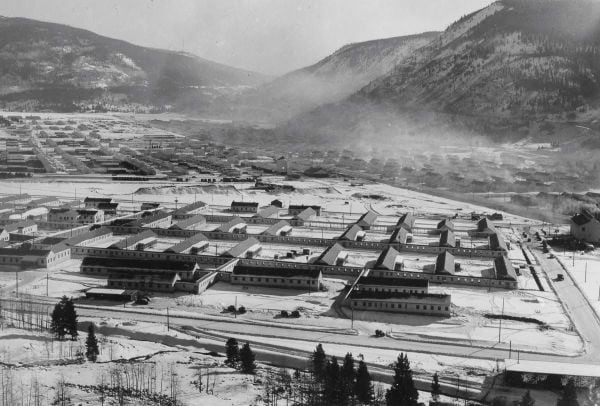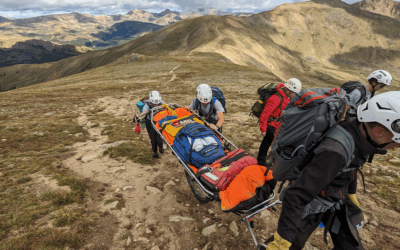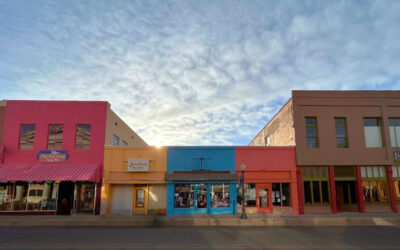From Camp Hale to Combat: The Story of the 10th Mountain Division
By Emma Tomasko
Tucked away in the Colorado Rocky Mountains, where snow covered the peaks and temperatures dropped below zero, a new kind of American soldier was born. In April of 1942, Camp Hale was established as a warfare training camp in preparation for World War II. It is known as the highest and most scenic military post in the nation.1 Standing at an elevation of 9,200 feet, Camp Hale would soon be home to rigorous and demanding training for future soldiers. Camp Hale was established as a military training ground by George C. Marshall, Army Chief of Staff. Marshall witnessed a small force of Greek mountaineering soldiers defeat a large Italian troop, ultimately convincing him to create a mountaineering branch within the US Army. 2 Camp Hale was named after Brigadier General Irving Hale, who was a brilliant leader in the Spanish American War and the Philippines War. While General Irving Hale passed away before Camp Hale was established, the training ground was named in his honor to recognize his infamous contributions to the military. He was named brigadier general by President William McKinley on May 4, 1899. 3
Camp Hale was built on 1,457 acres of the Pando Valley, just outside Leadville Colorado. It consisted of over 1,000 buildings that could potentially support 15,000 men. The camp was basically a small town and included barracks, a hospital, stables, a gymnasium and many other structures. 4 When the soldiers arrived in January of 1943, they were forced to adapt to the high elevation and the winter conditions. Temperatures would drop to as low as negative twenty degrees, causing the soldiers’ socks and boots to freeze at any time. The soldiers quickly became familiar with tactics that would help prevent frostbite. One of these strategies was using bacon grease as a layer of protection. Another strategy they used was taking sleeping shifts. One soldier would wake up another and put their feet against his warm stomach, and then would switch places after some time. 5 Tactics like these ultimately decreased the likelihood of developing frostbite, which in many cases lead to death.
In addition to frostbite, soldiers suffered from an illness called the Pando Hack. The Pando Hack was essentially a miserable cough that was caused from the nearby railroad, which infiltrated the air with enormous amounts of coal smoke and often caused soldiers to have to transfer into a different division. A thick layer of smoke would sit in the valley, encouraging the soldiers to climb above the smog to breathe clean air. However, climbing to fresh air wasn’t an option for everyone. Many of the soldiers’ had a hard time adjusting to the altitudes. Altitude sickness was a major obstacle that the soldiers had to face. Climbing up mountains far above tree line caused countless soldiers to fall sick. Training at Camp Hale was both physically and mentally demanding. Due to the harsh training conditions, Camp Hale was nicknamed “Camp Hell”.6

Train exhaust sits over the Camp Hale hospital complex, causing many soldiers to develop the “Pando Hack”, a serious lung condition. Photo used with permission of Denver Public Library.
After about two years of rigorous training, the troops were deployed to Italy where they would fight in one of the most risky and crucial war operations of World War II. On February 18th, the troops climbed up the steep and icy ridge of the northern Apennine mountains to fight in their first combat known as the Battle of Riva Ridge. The sun had set and the temperatures were rapidly dropping. Because of the meticulous conditions, the Germans believed that the ridge was unclimbable and therefore didn’t defend the areas that the US soldiers snuck up on. The American soldiers, however, were adequately prepared for this type of maneuvering. The mountainous terrain in Colorado was fortunately similar to the Italian ridges. The soldiers surprised the Germans and therefore were able to defeat them and secure the ridge six days later. This battle was instrumental to their next success at Mount Belvedere.
Once again, the soldiers climbed up steep terrain, about a 3,000 foot climb. Conquering Mount Belvedere was essential because it would prevent the Germans from successfully escaping by blocking their route. Obstructing their route to safety would prohibit the Germans from retreating or regrouping, allowing the Allied forces to accelerate further to victory. The Battle of Mount Belvedere was brutal and gruesome. The Germans were equipped with big machine guns and mortars. After five days of vicious fighting, the Tenth Mountain Division troops had successfully captured the mountain. These two battles ultimately became a major turning point in the war that weakened the German forces. 7
In October of 1945, Camp Hale was torn down. Camp Hale was meant to be built as a temporary training ground, hence why it wasn’t called Fort Hale. Prisoners of the war were ordered to go deconstruct the facility. Once dismantled, the buildings were sent to Fort Carson just outside of Colorado Springs to be reused, 8 and the land was given to the White River National Forest. 9 Once the soldiers had vacated, Camp Hale entered a long restoration process, in an attempt to transform it back to its original state. In fact, restoration is still occurring at Camp Hale today. The foundations of several buildings were buried and the soil was revegetated. In 1990, the Camp Hale Military Munition Project arrived to remove any dangerous munitions in the area. In addition, recent efforts to restore the wetlands and Eagle River stream have been ongoing. Since then, two campgrounds have been established: the Camp Hale Memorial Campground and the East Fork Campground. 10
It wasn’t until October of 2022 that Camp Hale was named a National Monument by President Biden, establishing the monument under the 1906 Antiquities Act. 11 Biden’s decision to make Camp Hale a monument brings awareness to the importance of the area and how it set the precedent for the outdoor industry. In addition, the monument allows us to honor the military history, indigenous heritage, and cultural impact of the land. Long before the 10th mountain division, Camp Hale was home to thousands of Ute tribes. Countless generations of Utes lived at Camp Hale before they were forced out in 1868. “By preserving these areas of cultural importance to the Ute people, the President is reflecting the significance of Native people and tribal nations to the history and progress of this country.” 12 Camp Hale serves as an area of remembrance to those tribes who first inhabited the land. In addition, the Camp Hale Monument allows us to recognize both the origin and influence of the ski industry. After World War II, the 10th mountain division veterans realized their experiences at Camp Hale had fostered a deep love and connection to the outdoors. Many veterans worked to establish ski resorts, schools, and equipment. Veterans Peter Seibert, Harley Higbie, and many others established Vail Resort, which is home to about 1.7 million skiers per year. 13 Other large resorts like Aspen, Sun Valley, and Mammoth Mountain were also created by 10th mountain division veterans. 14
Understanding the significance of Camp Hale is crucial for recognizing its contribution in World War II, the remembrance of Indigenous heritage, and the development of the ski industry. Camp Hale plays a fundamental role in the history of the western United States and should be remembered as a birthplace of courage, innovation, and resilience. So, next time you find yourself on the slopes, wind ripping and snow squalling, just remember you’re skiing on the tracks of legends.
Emma Tomasko is a student at Jefferson Academy high school. She runs cross country and track and is a member of the National Honors Society, Spanish Honors Society, and Fellowship of Christian Athletes. Outside of school, she enjoys skiing, biking, and hiking with her friends. She is passionate about the outdoors and hopes to pursue a future that combines her love for nature, environmental advocacy, and community engagement.
Endnotes
1 “Building Camp Hale: A Deeper History of America’s High-Altitude Army T,” www.historycolorado.org, n.d., https://www.historycolorado.org/story/2022/10/07/building-camp-hale-deeper-history-americas-high-altitude-army-training-ground.
2 The Flagship Staff, “Our History Is Also Epic! U.S. Army’s Tenth Mountain Division’s Role in WWII and Its Connection to Vail Resorts,” Military News, October 12, 2023, https://www.militarynews.com/norfolk-navy-flagship/community/our-history-is-also-epic-u-s-army-s-tenth-mountain-division-s-role-in/article_e23d1a94-692d-11ee-af0b-7bc0b67f3f70.html.
3 “Training the Tenth Mountain Division,” accessed March 13, 2025, https://sitesed.cde.state.co.us/pluginfile.php/61349/mod_book/chapter/9807/Camp%20Hale%20and%20the%2010th%20Mountain%20Division.pdf?time=1622653247464.
4 “Training the Tenth Mountain Division,” accessed March 13, 2025, https://sitesed.cde.state.co.us/pluginfile.php/61349/mod_book/chapter/9807/Camp%20Hale%20and%20the%2010th%20Mountain%20Division.pdf?time=1622653247464.
5 “Mountaineering Training at Camp Hale · Camp Hale · the 10th Mountain Division,” camphale.omeka.net, n.d., https://camphale.omeka.net/exhibits/show/camphale/mountaineeringtraining.
6 “Training the Tenth Mountain Division,” accessed March 13, 2025, https://sitesed.cde.state.co.us/pluginfile.php/61349/mod_book/chapter/9807/Camp%20Hale%20and%20the%2010th%20Mountain%20Division.pdf?time=1622653247464.
7 “The 10th Mountain Division’s Deadly Uphill Battle in Italy,” HistoryNet, January 21, 2020, https://www.historynet.com/the-10th-mountain-divisions-deadly-uphill-battle-in-italy/.
8 yongli, “Camp Hale,” coloradoencyclopedia.org, September 10, 2015, https://coloradoencyclopedia.org/article/camp-hale.
9 Annie Addison, “Camp Hale’s ‘Second Generation,’” Aspentimes.com (AspenTimes.com, March 21, 2007), https://www.aspentimes.com/news/camp-hales-second-generation/.
10 yongli, “Camp Hale,” coloradoencyclopedia.org, September 10, 2015, https://coloradoencyclopedia.org/article/camp-hale.
11 “President Biden Designates Camp Hale-Continental Divide National Monument,” Usda.gov, October 12, 2022, https://www.usda.gov/about-usda/news/press-releases/2022/10/12/president-biden-designates-camp-hale-continental-divide-national-monument.
12 Sudrum.com, 2025, https://www.sudrum.com/news/2022/10/21/tribal-acknowledgement-at-camp-hale/.
13 John LaConte, “Vail Resorts Reports Skiers Visits Are down by Nearly 8%,” Vaildaily.com (VailDaily.com, April 20, 2024), https://www.vaildaily.com/news/vail-resorts-reports-skiers-visits-are-down-by-nearly-8/.
14 Sarah Kuta, “Biden Declares His First National Monument at Colorado’s Camp Hale,” Smithsonian Magazine, October 14, 2022, https://www.smithsonianmag.com/smart-news/camp-hale-is-colorados-newest-national-monument-180980944/.
Bibliography
Addison, Annie. “Camp Hale’s ‘Second Generation.’” Aspentimes.com. AspenTimes.com, March 21, 2007. https://www.aspentimes.com/news/camp-hales-second-generation/.
camphale.omeka.net. “Mountaineering Training at Camp Hale · Camp Hale · the 10th Mountain Division,” n.d. https://camphale.omeka.net/exhibits/show/camphale/mountaineeringtraining.
HistoryNet. “The 10th Mountain Division’s Deadly Uphill Battle in Italy,” January 21, 2020. https://www.historynet.com/the-10th-mountain-divisions-deadly-uphill-battle-in-italy/.
Kuta, Sarah. “Biden Declares His First National Monument at Colorado’s Camp Hale.” Smithsonian Magazine, October 14, 2022. https://www.smithsonianmag.com/smart-news/camp-hale-is-colorados-newest-national-monument-180980944/.
LaConte, John. “Vail Resorts Reports Skiers Visits Are down by Nearly 8%.” Vaildaily.com. VailDaily.com, April 20, 2024. https://www.vaildaily.com/news/vail-resorts-reports-skiers-visits-are-down-by-nearly-8/.
Staff, The Flagship. “Our History Is Also Epic! U.S. Army’s Tenth Mountain Division’s Role in WWII and Its Connection to Vail Resorts.” Military News, October 12, 2023. https://www.militarynews.com/norfolk-navy-flagship/community/our-history-is-also-epic-u-s-army-s-tenth-mountain-division-s-role-in/article_e23d1a94-692d-11ee-af0b-7bc0b67f3f70.html.
Sudrum.com, 2025. https://www.sudrum.com/news/2022/10/21/tribal-acknowledgement-at-camp-hale/.
“Training the Tenth Mountain Division.” Accessed March 13, 2025. https://sitesed.cde.state.co.us/pluginfile.php/61349/mod_book/chapter/9807/Camp%20Hale%20and%20the%2010th%20Mountain%20Division.pdf?time=1622653247464.
Usda.gov. “President Biden Designates Camp Hale-Continental Divide National Monument,” October 12, 2022. https://www.usda.gov/about-usda/news/press-releases/2022/10/12/president-biden-designates-camp-hale-continental-divide-national-monument.
www.historycolorado.org. “Building Camp Hale: A Deeper History of America’s High-Altitude Army T,” n.d. https://www.historycolorado.org/story/2022/10/07/building-camp-hale-deeper-history-americas-high-altitude-army-training-ground.
yongli. “Camp Hale.” coloradoencyclopedia.org, September 10, 2015. https://coloradoencyclopedia.org/article/camp-hale.



